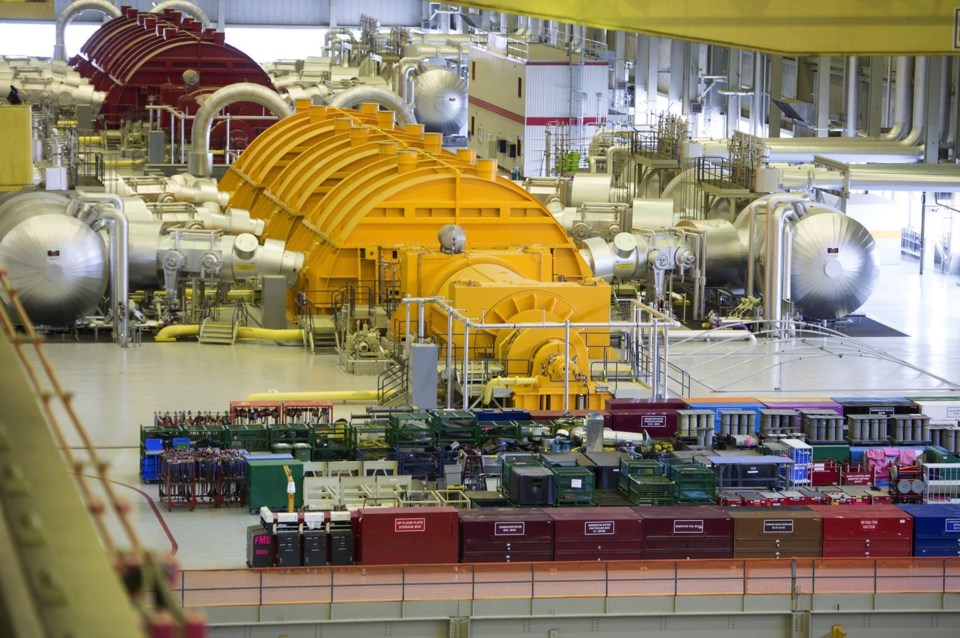CLARINGTON, Ont. — Ontario's new energy minister is unapologetic about the province's use of natural gas to partly fuel growing energy needs, calling opposition to it "ideological."
Stephen Lecce took over the portfolio last week in a cabinet shuffle, when he was moved from the education file that he oversaw for five years.
Premier Doug Ford also gave the ministry a new name, dubbing it the Ministry of Energy and Electrification, and Lecce said it is about building the energy infrastructure needed to meet the demands of the economy, including large-scale manufacturing facilities such as the electric vehicle battery plants being built in the province by Volkswagen, Stellantis and Honda.
"The reality is we need more energy and the mission of our government is to build upon Ontario's already ambitious plan to scale up our energy using all forms, be it nuclear and natural gas and renewables," Lecce said Thursday at a news conference.
"We need to take an all-of-the-above approach to build for the future."
Ontario's electricity system operator recently procured new power supply from 10 battery storage facilities, which can charge during off-peak hours and inject energy back into the grid when it's needed, as well as three natural gas and biogas facilities.
The new 20-year contracts are for electricity supply set to come online between 2026 and 2028 and the Independent Electricity System Operator has said the province will now have enough electricity for the rest of this decade.
But while the government has said recent moves to add more natural gas generation to the electricity system were necessary in order to ensure enough supply and flexibility – particularly as nuclear plants undergo refurbishments – it has caused greenhouse gas emissions from the sector grow.
In 2021, the electricity system was 94 per cent emissions free, but that is now down to 87 per cent.
Lecce said Thursday that Ontario's grid is still one of the cleanest on the continent, and, he emphasized, the government's decisions will ensure it remains reliable and affordable.
"What we will not do, and I cannot underscore this enough, is we will not pursue a path, an ideological path, that will deny some forms of energy when we need all of them to help fuel our economy," he said.
Green Party Leader Mike Schreiner said Lecce's comments are "totally disconnected from the reality Ontario is facing."
"Ramping up expensive, dirty gas plants makes no sense when people are facing an affordability crisis and a climate emergency," he wrote in a statement.
The IESO said in a 2022 report that Ontario could fully eliminate natural gas in the electricity system by 2050, starting with a moratorium in 2027, but it would require between $375 and $425 billion in capital costs over 23 years, including building new, large-scale nuclear plants, resulting in annual operating costs of about $60 billion by 2050 — three times the current costs.
If consumer costs become too high, it could jeopardize the plan to decarbonize, the IESO said.
The former Liberal government faced widespread anger over high hydro bills, driven up in part by long-term contracts at above-market rates with clean power producers secured in order to spur a green energy transition.
Ontario is planning to add more wind and solar power to the mix, as well as forging ahead with adding nuclear, including exploring a new, large-scale plant at Bruce Power in Tiverton, Ont., seeking permission to refurbish units at the Pickering nuclear plant, and building four small modular reactors at the Darlington nuclear facility.
Lecce announced Thursday that the first phase of site preparation for the first small modular reactor was complete.
The reactors will produce 1,200 megawatts of electricity, enough to power more than one million homes.
Lecce also announced that a subsidiary of Ontario Power Generation has secured a $360-million deal to help refurbish a nuclear plant in Romania.
As part of the Romanian deal, Ontario nuclear workers will provide their expertise on the refurbishment after the federal government came to an agreement with the European country to provide work on its lone nuclear plant.
This report by The Canadian Press was first published June 13, 2024.
Allison Jones, The Canadian Press



